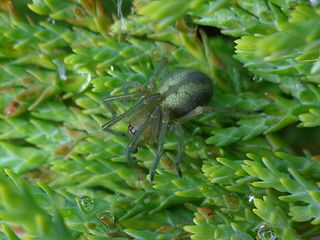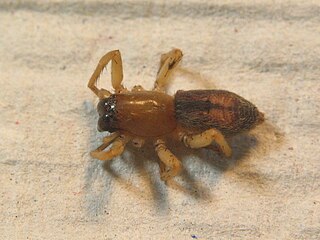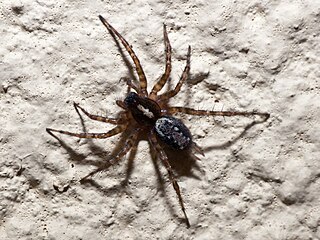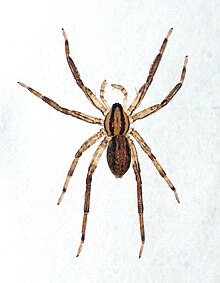
Wolf spiders are members of the family Lycosidae. They are robust and agile hunters with excellent eyesight. They live mostly in solitude, hunt alone, and usually do not spin webs. Some are opportunistic hunters, pouncing upon prey as they find it or chasing it over short distances; others wait for passing prey in or near the mouth of a burrow.

Apatura iris, the purple emperor, is a Palearctic butterfly of the family Nymphalidae.

Zoropsis spinimana is a spider species belonging to the family Zoropsidae.

Alopecosa accentuata is a species of wolf spider found commonly in open habitats throughout continental Europe with a reported palearctic distribution. The female has a body length of up to 12 mm, the male is rather smaller at up to 9 mm. The name was at one time treated as a nomen dubium, but is now considered the correct name of Alopecosa barbipes.

Noctua orbona, the lunar yellow underwing, is a moth of the family Noctuoidea. It is found in the Palearctic.

Ozyptila trux, the yellow leaflitter crab spider, is a crab spider species with Palearctic distribution.
Trochosa spinipalpis is a specialised species of Palearctic, wolf spider which is restricted to bogs and other wetlands.

Cheiracanthium erraticum, the two-clawed hunting spider, is a species of Palearctic spider of the family Cheiracanthiidae.

Xysticus cristatus, the common crab spider, is a European spider from the family Thomisidae.

Xysticus ulmi, the swamp crab spider, is a European crab spider of the family Thomisidae which prefers damp habitats. It was first described by the German zoologist Carl Wilhelm Hahn in 1831.
Cryphoeca silvicola is a small species of dwarf sheet spider in the family Cybaeidae which has a Palearctic distribution. The generic name, Cryphoeca, means hidden and the specific name silvicola means "living in the woods".

Heliophanus cupreus, the copper sun jumper, is a species of jumping spider belonging to the family Salticidae.

Clubiona subsultans, the Caledonian sac spider, is a spider from the family Clubionidae with a Palearctic distribution.

Zora is a genus of spiders in the family Miturgidae, consisting of small to medium entelegyne, ecribellate spiders. They can be identified as they have two claws with claw tufts, distinct longitudinal bands on the cephalothorax, 4-2-2 arrangement of the eight eyes and long overlapping spines on the first two tibiae and metatarsi. Their abdomens show distinct colour patterns which may be useful in identification to species. There are 17 species in the genus which have a Holarctic distribution, mostly in Europe and the Middle East but with two species in North America. The type species is Zora spinimana.

Zora silvestris is a prowling spider in the family Miturgidae which is found in Europe and Central Asia.

Micaria pulicaria, the glossy ant spider, is a species of ground spider from the family Gnaphosidae with a Holarctic distribution.

Zelotes subterraneus is a species of ground spider from the family Gnaphosidae which has a Palearctic distribution. it is the type species of the genus Zelotes. Its distribution may be somewhat masked by the difficulty of distinguishing this species from Zelotes apricorum and Zelotes latreillei.

Anitistea elegans, the marsh combtail, is a species of dwarf sheet web spider in the family Hahniidae which has a Palearctic distribution.

Textrix is a genus of funnel weavers first described by Carl Jakob Sundevall in 1833. They have a mainly European distribution, with one species in Ethiopia. The type species of the genus is Textrix denticulata.

Tetragnatha montana, commonly known as the silver stretch spider, is a species of long-jawed orb weaver from the family Tetragnathidae that has a Palearctic distribution. It preys mostly on flies and mosquitoes. The name silver stretch spider refers to its shiny metallic colour and its habit of extending its legs into a stick like shape.

















